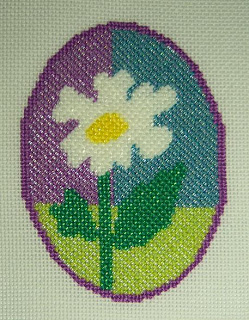 If you've ever purchased a painted canvas that you absolutely couldn't make stitch right, it was probably badly drawn before it was painted, as a well prepared canvas has to start with a good drawing - well placed on the threads where the stitches go. Too many commercial canvases these days don't take care to do this, and take the pleasure out of working them.
If you've ever purchased a painted canvas that you absolutely couldn't make stitch right, it was probably badly drawn before it was painted, as a well prepared canvas has to start with a good drawing - well placed on the threads where the stitches go. Too many commercial canvases these days don't take care to do this, and take the pleasure out of working them. Also, I am seeing a number of people via the blogs who are wanting to draw their own, and I cringe when I look at them, as they make the classic mistake of drawing in between the threads (in the groove) instead of ON the thread.
This little design was originally made as a brief but simple tutorial for teaching people to properly trace a design. It is only 4 1/4" high, but has the elements needed for learning and for practice. I used it one day to work on some beading techniques I was developing - the use of clear beads applied with the same floss as the background color. (very effective!)
I have asked Gail Hendrix and Anne Stradal to please not look at this issue of Freebies, as Gail will faint (she totally stitch paints everything) and Anne will raise her eyebrows, I'm sure, as she also stitch paints everything. She does what I do in many cases - she places the canvas over the master pattern and traces it, but she "stitch dots" as she goes. I haven't felt this necessary on most of my larger canvases, but I am fanatic about doing it on anything symmetric - and on other elements that need to be carefully placed to look right.
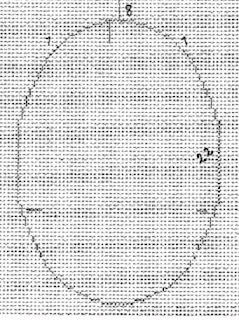 Anyway, the thing is to trace the design onto the canvas by placing it over the drawing, and do it CAREFULLY with a light touch - so as not to make an ugly, hard black line. I made the lines dark here in order to show up well.
Anyway, the thing is to trace the design onto the canvas by placing it over the drawing, and do it CAREFULLY with a light touch - so as not to make an ugly, hard black line. I made the lines dark here in order to show up well.This is the oval around the flower design if you want to try the whole thing. Draw it onto canvas first before you trace the design onto it - following the instructions given previously for other symmetric shapes.
I have marked arrows on the drawing on the oval to illustrate that I took care to hit the THREAD as I went around curves, etc. and not slip into the groove between the threads. This makes a design soooo much easier and prettier to stitch, and if the canvas is drawn this way, it will naturally be painted this way as well. I stitch traced the flower center out of habit - and will change, (if I decide to do anything with it) the upper left side of the center. This just involves dotting out what I did with white acrylic paint and re-doing it.
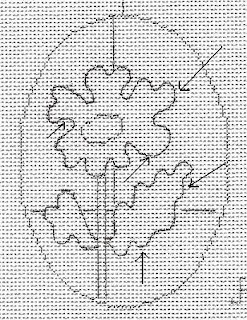 Incidentally, this drawing is the actual size of the real canvas (I think it is, anyway) so you can trace directly from it after printing it out.
Incidentally, this drawing is the actual size of the real canvas (I think it is, anyway) so you can trace directly from it after printing it out. On the next oval with the flower, I have purposely drawn it badly - see the arrows. This was very difficult for me, as my habit after 40 years of designing painted canvas was
nearly impossible to break. With those lines in the grooves between the threads, the poor stitcher has to make a decision about where to put the stitch to make the shape of the curve look right.
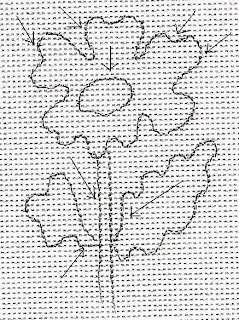
I'm including this simple tracing of the design in case you want to re-size it and use it for something else - it's great for practice! Just enlarge or reduce as you wish, and use it for something clever!!
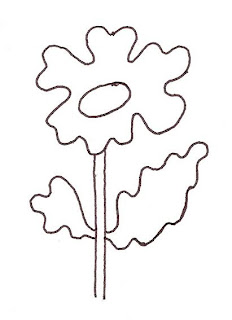
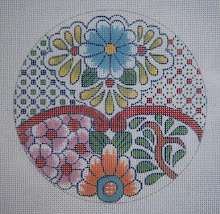
Judy,
ReplyDeleteYour tracing tutorial cound not be more timely. I am attempting the President's Project of the CyberPointers chapter. Additionally, I have joined the Special Interest Group to stitch Tony Minieri's Stitch of the Month, Glittering Kimono. In each of these, the design must be traced. I am new at needlepointing, so all is a "new adventure." One question: Do you secure the canvas to the traced paper? Any special trick?
I must tell you that I read your blog faithfully, and have learned much. I only wish I was your neighbor.
Thank you.
Nancy
Nancy - I can't find an e-mail address for you. Mine is on my profile, etc. - please e-mail me with any questions you have, and I'll guide you through it. It's actually very very simple, but there are "tricks."
ReplyDeleteI,too am a novice at this work. I generally do counted stuff. My questions are the same as Nancys,so please send me some of your best hints !!
ReplyDeleteDonna
Donna - your e-mail was a "no reply" so i have no way to answer your questions - please look at my profile, and send me an e-mail from the address there. There are lots of posts also on the other blog Possibilities on drawing on canvas, as well as my book on my web page.
ReplyDeleteJudy,
ReplyDeleteDo you have any tips/suggestions for painting a belt canvas?
Thank you!
Barbara